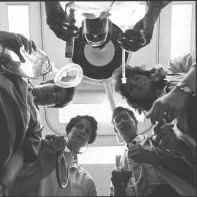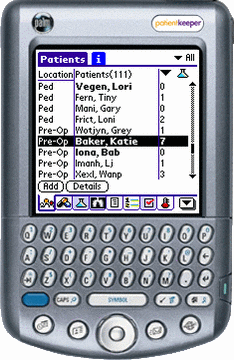|
A
50 year-old man presented to the ED after having sustained
several cat bites and scratches to his left hand
three hours prior to arrival while separating his fighting
pets. The patient was a known Type II  diabetic
and also allergic to penicillin (manifested by immediate
hives). The patient was afebrile and exhibited
several cat bite punctures on the dorsum of his hand, in
addition to several other scratches. His exam is
depicted in the video below, during which he is asked to
make a fist. diabetic
and also allergic to penicillin (manifested by immediate
hives). The patient was afebrile and exhibited
several cat bite punctures on the dorsum of his hand, in
addition to several other scratches. His exam is
depicted in the video below, during which he is asked to
make a fist.
Review the video and carefully review the x-rays and
consider how you would treat this patient. Of note,
the erythema was circled with a pen upon arrival to the ED,
and the video was taken less than one hour later.


The
presentation of this infected cat bite is notable
for: a) The aggressive nature of the infection.
As noted, the findings on exam have all appeared in the
three short hours following the bite. Already the
patient exhibits marked erythema, edema, and limitation of
flexion of his fingers. Note that in the hour since
the visible erythema was circled, it is already seen to
extend beyond the ink mark on the video. b) The
finding of air in the soft tissues along the dorsum of the
hand on the lateral X-ray of the hand.
Infected cat bites tend have a complex microbiologic mix
(2). However, in this particular case, two specific
pathogens must be targeted when considering treatment:
1) Pasteurella multocida. More than 50%
of cat bite wounds become infected and P. multocida
is found as a pathogen over 75% of the time (3).
Infection with P. multocida is characterized by
extremely rapid onset. Local pain and inflammation often
occur within 4 to 6 hours of the injury and almost always
within 24 hours. This patient did not exhibit purulent
discharge, which is seen with P. multocida in 40% of
cases (3).
2) Beta hemolytic streptococcus.
This pathogen is also a common cause of cat bite infections
and also is known to be associated with a rapid onset of
infection. The air in the soft tissues suggests
streptococcal infection, but it is by no means
pathognomonic.
Ampicillin/sulbactam would have been chosen to treat this
patient if not for his penicillin allergy. The choice
of antibiotics in penicillin-allergic patients is more
difficult and is based primarily on in vitro sensitivity
since data on clinical efficacy are less than adequate (5).
This patient was
started on intravenous doxycycline (coverage against P.
Multocida) and clindamycin (excellent streptococcal
coverage). The plan was to closely follow the patient
clinically and if there was no improvement, to have him
undergo surgical incision and drainage. In fact, the
patient exhibited dramatic improvement by the next morning
such that he went home after 48 hours in the hospital, on
oral antibiotics.
References:
(1) Goldstein EJC: Bite wounds and infection. Clin
Infect Dis 1992;14:633-8.
(2) Talan DA, et al. Bacteriologic analysis
of infected dog and cat bites. Emergency Medicine Animal
Bite Infection Study Group N Engl J Med 1999 Jan
14;340(2):85-92.
(3) Mandell: Principles
and Practice of Infectious Diseases, 5th ed., Copyright
2000 Churchill Livingstone, Inc.
(4) Schlossberg: Current Therapy of Infectious
Disease, 2nd ed., Copyright 2001 Mosby
(5) Fauci:
Harrison
's Principles of Internal Medicine, 14th ed.
Copyright 1998 McGraw Hill
The
above case from:

Link
to further Information on:

|









 DISCLAIMER:
This website is designed primarily for use by qualified
physicians and other medical professionals. The
information provided here is for educational and
informational purposes only. It is not guaranteed to be
correct and should NOT be considered as a substitute for
the advice of an appropriately qualified expert. In no way
should the information on this site be considered as
offering advice on patient care decisions or establishment
of a patient-physician relationship.
DISCLAIMER:
This website is designed primarily for use by qualified
physicians and other medical professionals. The
information provided here is for educational and
informational purposes only. It is not guaranteed to be
correct and should NOT be considered as a substitute for
the advice of an appropriately qualified expert. In no way
should the information on this site be considered as
offering advice on patient care decisions or establishment
of a patient-physician relationship.